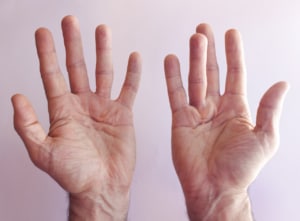What You Need To Know About Dupuytren’s Contracture
A Dupuytren’s contracture is the result of thickening fascia beneath the skin of the palm most often near the pinky and ring fingers. Over time the skin at the base of an affected finger will become thicker before finally creating a knot and dimple appearance. A knot formation is indicative of the fascia thickening aspect of Dupuytren’s. Fascia is a layer of tissue between the skin and muscle layers that help anchor down your skin. Otherwise, the skin on your palm could be manipulated much like the skin on the back of your hand. As the fascia tightens into a knot like structure, the tightened skin and fascia cause the fingers to become progressively flexed, making extending the fingers difficult. Unlike a similarly presenting problem, trigger finger, Dupuytren’s does not involve any tendons. Although there is no known cause of Dupuytren’s, there are several risk factors: • Gender: The prevalence is greater in men than women • Ancestral Descent: People from Northern European or Scandinavian descent are most likely to develop the condition • Age: Likelihood increase with age • Alcohol & Tobacco Use: People who smoke and drink more regularly are more likely to present with the [...]

